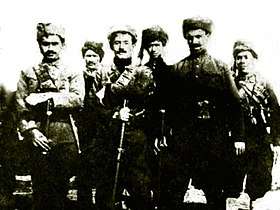Republic of Ararat
The Republic of Ararat, or Kurdish Republic of Ararat,[6][7][8] (Kurdish: Komara Agiriyê ,کۆماری ئارارات[9][10] and Kurdish: Komara Araratê[11]) was a self-proclaimed Kurdish state. It was located in eastern Turkey, centred on Karaköse Province. Agirî is the Kurdish name for Ararat.
Republic of Ararat Komara Agiriyê Komara Araratê | |||||||||
|---|---|---|---|---|---|---|---|---|---|
| 1927–1930 | |||||||||
.png) | |||||||||
| Capital | Kurd Ava[1] / Kurdava[2] (Doğubayazıt) | ||||||||
| Common languages | Kurdish | ||||||||
| Government | Republic | ||||||||
| President[3] | |||||||||
• 1927 - 1930 | Ibrahim Haski[4] | ||||||||
| Supreme Commander[4] | |||||||||
• 1927 - 1930 | Ihsan Nuri[4] | ||||||||
| Historical era | Interwar period | ||||||||
• Independence declared[5] | 28 October 1927 | ||||||||
• Retaken by Turkey | September 1930 | ||||||||
| |||||||||
History
The Republic of Ararat, led by the central committee of Xoybûn party, declared independence on 28 October 1927[5] or 1928,[8][12][13] during a wave of rebellion among Kurds in southeastern Turkey.
At the first meeting of Xoybûn, Ihsan Nuri Pasha was declared the military commander of the Ararat Rebellion.[14] In October 1927, Kurd Ava,[1] or Kurdava,[2] a village near Mount Ararat, was designated as the provisional capital of Kurdistan. Xoybûn made appeals to the Great Powers and the League of Nations and also sent messages to other Kurds in Iraq and Syria to ask for co-operation.[15] But under the pressure from Turkey, the British Empire as well as France imposed restrictions on the activities of the members of Xoybûn.[14]
The Turkish military subsequently defeated the Republic of Ararat in September 1930.[16]

References
- Wadie Jwaideh, The Kurdish national movement: its origins and development, Syracuse University Press, 2006, ISBN 978-0-8156-3093-7, p. 211.
- (in French) Celal Sayan, La construction de l'état national turc et le mouvement national kurde, 1918-1938, Presses universitaires du septentrion, 2002, p. 649.
- Paul J. White, Primitive rebels or revolutionary modernizers?: the Kurdish national movement in Turkey, Zed Books, 2000, ISBN 978-1-85649-822-7, p. 77.
- (in Turkish) Emin Karaca, Ağrı Eteklerinde İsyan: Bir Kürt Ayaklanmasının Anatomisi, 3. Baskı, Karakutu Yayınları, 2003, ISBN 975-8658-38-7, s. 23.
- Dana Adams Schmidt, Journey among brave men, Little, Brown, 1964, p. 57.
- Christopher Houston, Kurdistan: crafting of national selves, Indiana University Press, 2008, ISBN 0-253-22050-5, p. 52.
- Encyclopedia of the Peoples of Africa and the Middle East, 1. cilt, Infobase Publishing, 2009, ISBN 978-0-8160-7158-6, p. 385.
- Abbas Vali, Essays on the origins of Kurdish nationalism, Mazda Publishers, 2003, ISBN 978-1-56859-142-1, p. 199.
- "Xwendin û danasîna pirtûkan". dengekurdistan.nu (in Kurdish). Retrieved 21 December 2019.
- "کۆماری ئارارات، ئاوڕدانەوەیەک لە مێژوو". chawykurd.com (in Kurdish). Retrieved 21 December 2019.
- "Ihsan Nuri Paşa" (in Kurdish). Retrieved 21 December 2019.
- Martin Strohmeier, Crucial images in the presentation of a Kurdish national identity: heroes and patriots, traitors and foes, Brill, 2003, ISBN 978-90-04-12584-1, s. 97.
- Christopher Houston, Kurdistan: crafting of national selves, Indiana University Press, 2008, ISBN 0-253-22050-5, s. 52.
- Allsopp, Harriet (2014). The Kurds of Syria: Political Parties and Identity in the Middle East. London: I.B. Tauris. p. 55. ISBN 9781780765631.
- Edmonds, C.J. (1971). "Kurdish Nationalism". Journal of Contemporary History. 6 (1): 91. doi:10.1177/002200947100600105.
- Kemal Kirişci,Gareth M. Winrow, The Kurdish Question and Turkey: An Example of a Trans-state Ethnic Conflict, Routledge, 1997, ISBN 978-0-7146-4746-3, p. 101.
- Rohat Alakom, Hoybûn örgütü ve Ağrı ayaklanması, Avesta, 1998, ISBN 975-7112-45-3, p. 180. (in Turkish)